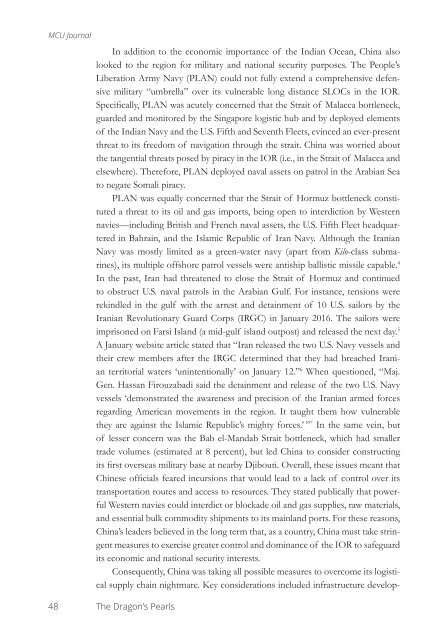Call for Submissions
1S7vIsW
1S7vIsW
You also want an ePaper? Increase the reach of your titles
YUMPU automatically turns print PDFs into web optimized ePapers that Google loves.
MCU Journal<br />
In addition to the economic importance of the Indian Ocean, China also<br />
looked to the region <strong>for</strong> military and national security purposes. The People’s<br />
Liberation Army Navy (PLAN) could not fully extend a comprehensive defensive<br />
military “umbrella” over its vulnerable long distance SLOCs in the IOR.<br />
Specifically, PLAN was acutely concerned that the Strait of Malacca bottleneck,<br />
guarded and monitored by the Singapore logistic hub and by deployed elements<br />
of the Indian Navy and the U.S. Fifth and Seventh Fleets, evinced an ever-present<br />
threat to its freedom of navigation through the strait. China was worried about<br />
the tangential threats posed by piracy in the IOR (i.e., in the Strait of Malacca and<br />
elsewhere). There<strong>for</strong>e, PLAN deployed naval assets on patrol in the Arabian Sea<br />
to negate Somali piracy.<br />
PLAN was equally concerned that the Strait of Hormuz bottleneck constituted<br />
a threat to its oil and gas imports, being open to interdiction by Western<br />
navies—including British and French naval assets, the U.S. Fifth Fleet headquartered<br />
in Bahrain, and the Islamic Republic of Iran Navy. Although the Iranian<br />
Navy was mostly limited as a green-water navy (apart from Kilo-class submarines),<br />
its multiple offshore patrol vessels were antiship ballistic missile capable. 4<br />
In the past, Iran had threatened to close the Strait of Hormuz and continued<br />
to obstruct U.S. naval patrols in the Arabian Gulf. For instance, tensions were<br />
rekindled in the gulf with the arrest and detainment of 10 U.S. sailors by the<br />
Iranian Revolutionary Guard Corps (IRGC) in January 2016. The sailors were<br />
imprisoned on Farsi Island (a mid-gulf island outpost) and released the next day. 5<br />
A January website article stated that “Iran released the two U.S. Navy vessels and<br />
their crew members after the IRGC determined that they had breached Iranian<br />
territorial waters ‘unintentionally’ on January 12.” 6 When questioned, “Maj.<br />
Gen. Hassan Firouzabadi said the detainment and release of the two U.S. Navy<br />
vessels ‘demonstrated the awareness and precision of the Iranian armed <strong>for</strong>ces<br />
regarding American movements in the region. It taught them how vulnerable<br />
they are against the Islamic Republic’s mighty <strong>for</strong>ces.’ ” 7 In the same vein, but<br />
of lesser concern was the Bab el-Mandab Strait bottleneck, which had smaller<br />
trade volumes (estimated at 8 percent), but led China to consider constructing<br />
its first overseas military base at nearby Djibouti. Overall, these issues meant that<br />
Chinese officials feared incursions that would lead to a lack of control over its<br />
transportation routes and access to resources. They stated publically that powerful<br />
Western navies could interdict or blockade oil and gas supplies, raw materials,<br />
and essential bulk commodity shipments to its mainland ports. For these reasons,<br />
China’s leaders believed in the long term that, as a country, China must take stringent<br />
measures to exercise greater control and dominance of the IOR to safeguard<br />
its economic and national security interests.<br />
Consequently, China was taking all possible measures to overcome its logistical<br />
supply chain nightmare. Key considerations included infrastructure develop-<br />
48 The Dragon’s Pearls


